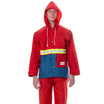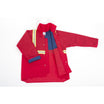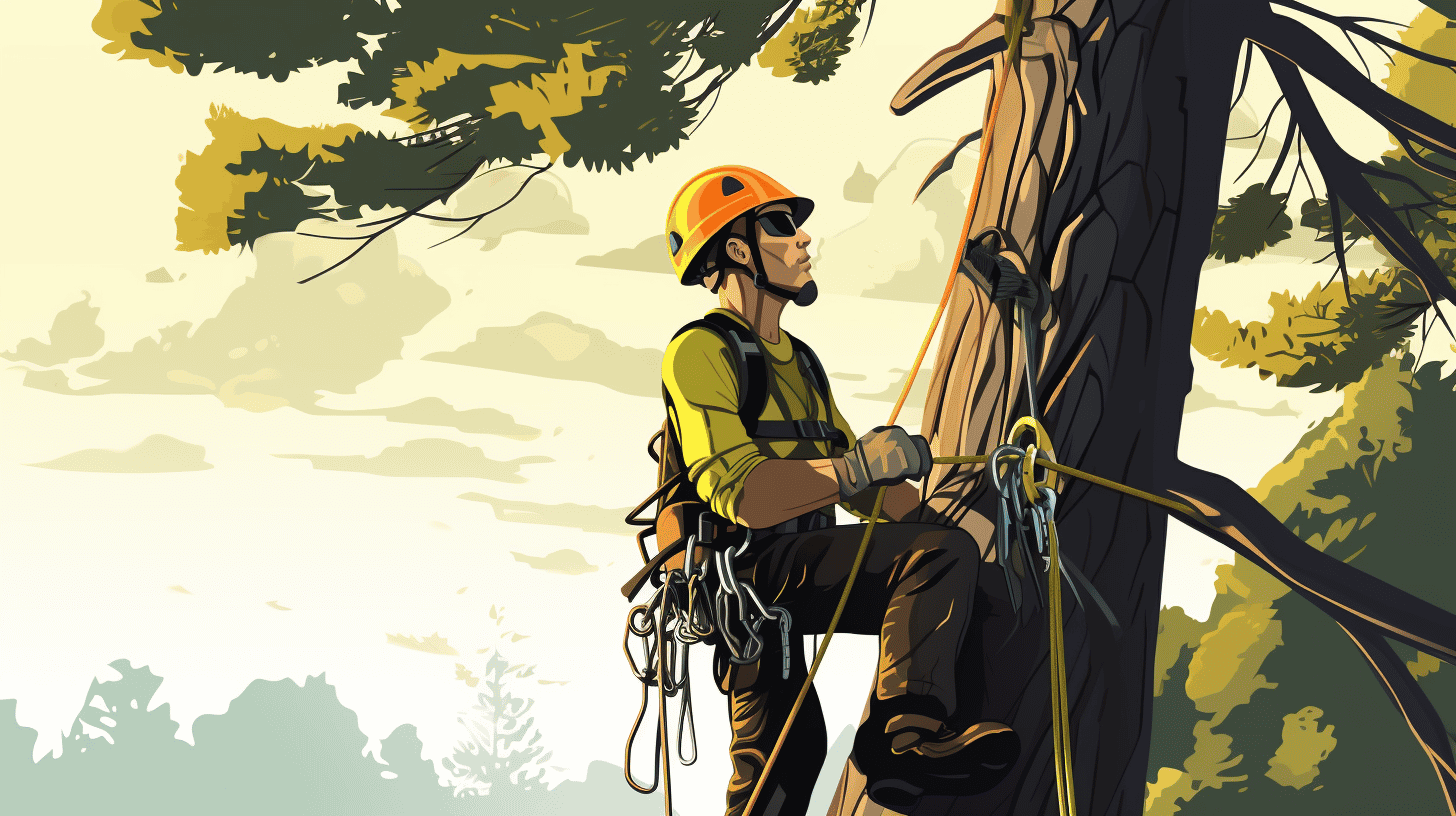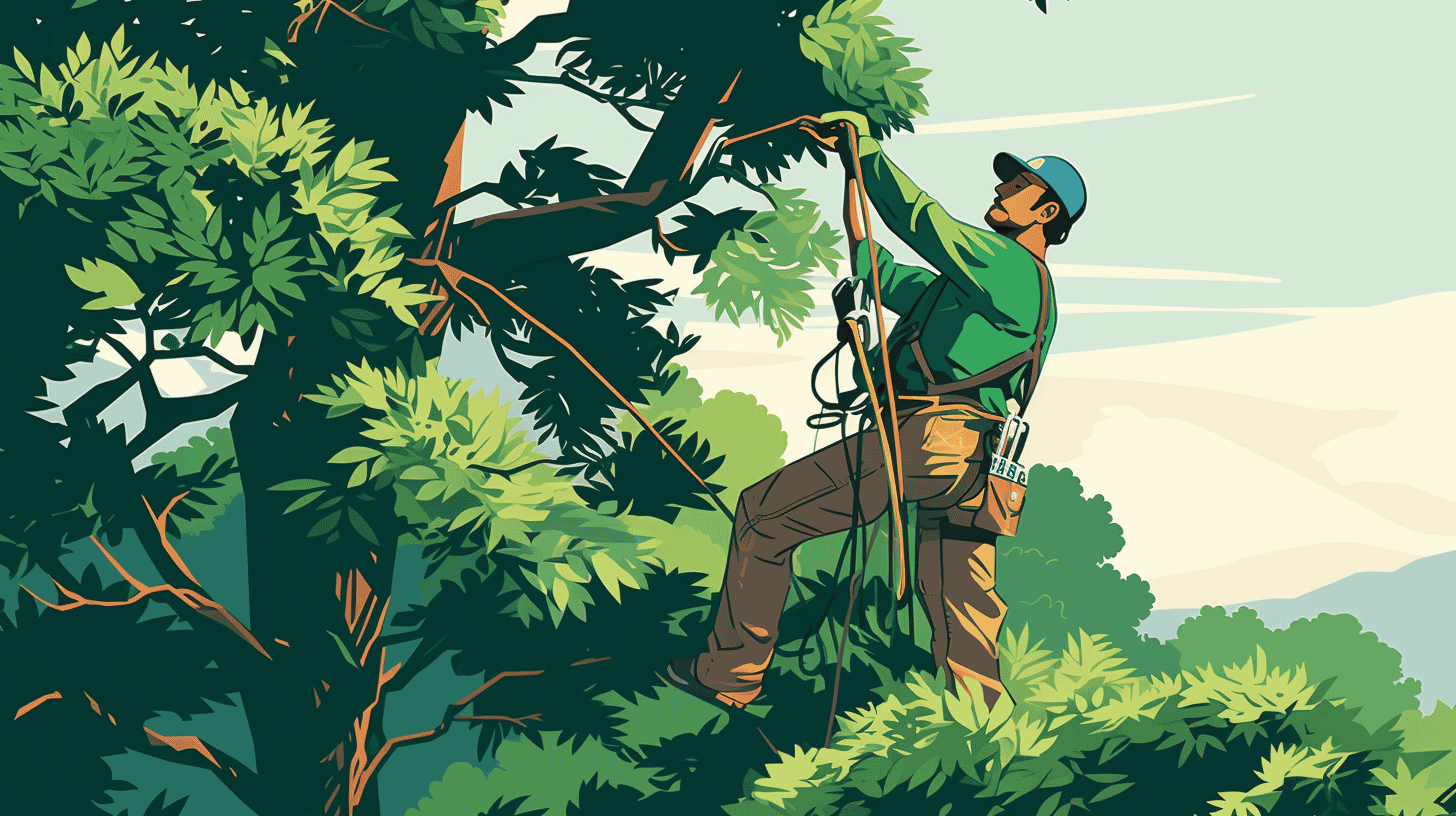Does the whisper of leaves, the crunch of twigs underfoot, and the majesty of tall trees captivate you? Then you're most likely familiar with the cherishing vocation of an arborist. This enchanting profession dwells in the art of tending, planting, and maintaining trees. Yet, as exciting and delightful as it might sound, it equally entails inherent risks. Over the years, the arborist industry has seen stellar growth and advancements, notably in the department of safety gear. But before we delve into the realm of arborist safety, it is equally crucial to comprehend the larger arborist industry's landscape.
In this guide, we will walk you through the crucial facets of arborist safety gear, starting from understanding the arborist industry to the essential safety gear, training, certifications, and more. This comprehensive guide aims to bring forth insights into the various tools arborists use to safeguard themselves while creating a heavenly green canopy for the world, setting a secure stage for the arborist industry in 2024. Your journey up the tree is about to get much safer and more insightful. So gear up, and let's dive right in.
Understanding The Arborist Industry
The Arborist Industry, a rapidly growing segment of the service industry, specializes in the care and maintenance of trees. Arborists are essentially tree doctors, ensuring the health and longevity of these magnificent botanical bodies. With the rising awareness about the environment and increasing urban landscaping needs, the industry has harvested significant growth over the past few years. The sector's scale and scope are defined by factors such as industry revenue, growth rate, arborist software market, and arborist management systems.
Industry Revenue
The yearning for green space amid urban sprawls has led to an appreciable increase in industry revenue. It is estimated that industry revenue would rise at a Compound Annual Growth Rate (CAGR) of 5.8%, amassing a sum of $35.6B over a period of just five years, leading to 2024. This surging revenue is driven by the increasing focus on environmental conservation and aesthetics, creating flourishing grounds for tree care services. In relation, the US Tree Trimming Services industry's market size is predicted to rise to a staggering $163.9B by 2024.
Growth Rate
Thanks to the escalating demand for professional tree services, the global tree care service market is set on a path of considerable growth. Rising environmental awareness coupled with growing landscaping needs are key drivers anticipating the industry’s growth between 2024 and 2032. And similar growth patterns reflect across different regions and sectors within the industry itself, pointing to a brighter, greener future.
Arborist Software Market
The rise of digital technology has transformed traditional industries and tree care services are not an exception. Modern arborists are adapting to digital ways, with the global arborist software market projected to jump to a massive USD 110,253.63M by 2031. This growth, showing a CAGR of 13.98%, demonstrates how software solutions like CRM, ERP, and project management tools are becoming increasingly important for ensuring efficient operations and superior customer service in the arborist industry.
Arborist Management System
With increasing expectations for service quality and transparency, efficient management systems become a necessity. The market for arborist management systems is set to register a CAGR of over 5% between 2024 and 2032. This indicates that arborist businesses are recognizing the need for streamlined operations, efficient workforce management, and accurate job costing - all offered by a robust arborist management system.
It is clear that the Arborist Industry is not just growing, but evolving significantly. The infusion of software services and management systems into traditional practices is creating an industry more efficient and effective in its service delivery. Undoubtedly, a greener tomorrow is taking shape beneath the shading branches of this flourishing industry.
Essential Arborist Safety Gear
Arborists, those brave professionals that inspect, treat, and take care of trees are often overlooked when it comes to the respect their job deserves. They skillfully wield equipment and climb towering trees daily, depending on their safety gear to protect them against potential hazards. This blog will shine some light on the essential arborist safety gear used in the field.
Helmets
Arborists are often working at significant heights, braving the uppermost branches of tall trees. A fall from such a location could easily result in a serious head injury. That's why a sturdy helmet is a critical part of any arborist's safety gear. High-quality arborist helmets are constructed to absorb high-impact blows, effectively reducing the risk of concussions. These helmets come equipped with a firm strap to ensure it remains secured on the operator's head regardless of the work situation.
Chainsaw Chaps
One of the arborist’s tools of the trade is the mighty chainsaw. This machine, which is incredibly efficient at chopping down trees and branches, also presents a significant safety risk. Chainsaw chaps, made from tough, high-density material, are designed to protect the operator's legs from accidental cuts. They often have layers of fabric that can quickly stop a moving chainsaw blade, reducing the risk of serious injury.
Eye Protection
Eye injuries are common in arboriculture, resulting from flying debris, dust, and sawdust. To safeguard against this, arborists equip themselves with heavy-duty eye protection. This gear ranges from basic safety glasses to full-face shields, depending on the level of exposure and risk. Regardless of the style, eye protection is made with impact-resistant lenses and frames, ensuring an arborist's vision remains uncompromised and sharp.
Personal Protective Equipment (PPE)
Beyond the aforementioned gear, there is a wide range of Personal Protective Equipment that arborists utilize based on the job at hand. This includes gloves, ear protection, high-visibility clothing, and safety boots. Each piece of PPE has a unique role in ensuring the safety of arborists, reducing the risk of workplace accidents and injuries.
Selecting the correct Personal Protective Equipment is crucial to ensure the safety of arborists. There are numerous factors to consider when selecting PPE, including comfort, durability, and appropriate level of protection. For those who are looking for the best quality products for arborists, ensuring that you meticulously choose each piece of equipment will go a long way in providing a safe and effective work environment.
Arborists have a vital role to play in our shared ecosystem, and their safety is paramount. By highlighting their need for top-tier safety equipment, we underscore the importance of their work. As they continue to brave the treetops, let's ensure they're well-equipped to do so safely.
Advancements in Arborist Safety Gear
The arborist industry has witnessed a significant surge in the development of safety equipment in recent years. Innovations are consistently reshaping the realm of tree-care, introducing safer and more efficient ways to carry out various tasks. This driving force for progressive change enhances not only the wellbeing of the arborists but also presents a potential for job efficiency and, ultimately, business growth.
New Product Launches
One of the most significant catalysts to the marked progress in arborist safety gear has been the consistent roll-out of new products. An array of well spotlighted tree-removal machines and climbing equipment have made their entry into the marketplace, each significantly increasing the safety and efficiency with which an arborist performs their job. These tools and equipment are not only easy to use but are also designed with the user's safety in mind, often featuring protective components that are vital when working at height or in potentially hazardous environments.
Ergonomic Tools
Crucial to the proactive advancements in arborist safety gear are ergonomic tools. They have revolutionized the industry by prioritizing workers' health, particularly their musculoskeletal well-being. Arborists often have to handle heavy tools and equipment for prolonged periods, which might lead to stress injuries over time. The introduction of ergonomic tools ensures that tools are more comfortable to handle, reducing potential fatigue and injury, while promoting overall safety in the workplace.
Rigging Equipment and Techniques
An arborist’s job is undeniably one of the most dangerous in the world, given the inherent risks of working at great heights and the unpredictable nature of trees. Underscoring the importance of safety, rigging equipment and techniques have seen substantial improvements. These innovations now offer greater stability and dependability when performing potentially precarious tasks.
Hearing Protection Technology
Finally, recent advancements in hearing protection technologies, such as the X-Series earmuffs, have been a game-changer in promoting not only safety but wellness amongst arborists. These high-tech devices are designed to significantly reduce noise levels, hence minimizing exposure to harmful noise causing potential hearing loss. They also enable communication at safe sound levels without removing the hearing protection device, providing both safety and convenience.
The evolution of arborist safety gear represents a pivotal shift in acceding that safety must be on the forefront of arboriculture. It ensures the longevity and sustainability of the profession, bestowing a safer and more efficient working environment that is welcome in any industry. Indeed, these advancements are a win-win for both the arborists and the business owners. For the arborists, these mean the reduced threat of injuries and, for the companies, the lower absenteeism due to injuries directly translates to greater productivity.
Certifications and Standards in the Arborist Industry
If you've ever harnessed the services of a professional arborist, you've likely encountered a maze of jargon encompassing a range of certifications and industry standards. For a layman, these terms may seem daunting and perplex. The validity and verity of these certifications are instrumental in ascertaining the competency and reliability of an arborist.
ISA Certification
The International Society of Arboriculture (ISA) credential is often considered the holy grail of arborist certifications. It validates the knowledge and skills of an arborist in an array of aspects associated with tree care. Achieving an ISA certification requires completing intensive training and successfully passing an extensive examination. It further entreats a commitment to maintain your certification through constant learning and adherence to a code of ethics.
Here's a brief gist of what ISA certification demonstrates:
- Comprehensive knowledge of arboriculture practices.
- A high degree of professionalism and adherence to industry standards.
- Commitment to safety both for themselves and their clients.
- Constant upskilling by keeping abreast with the latest developments in the field.
"Earning an ISA Certified Arborist credential is a testament to an individual's dedication and hard work and gives consumers trust in their expertise," emphasizes one industry expert.
Product Certifications
In addition to individual certifications, it's also necessary for arborists to use certified products and equipment. These range from protective apparel to tree-climbing gear and pruning tools. Arborist gear certified by reputable bodies such as the American National Standards Institute (ANSI) and the International Safety Equipment Association (ISEA) guarantees adherence to stringent safety and efficiency standards.
Trusting in product certifications ensures:
- The safety of you, your trees, and the professionals working on them.
- The efficacy of the services delivered.
- The durability and dependability of the equipment and protective gear in use.
Certifications in the arborist industry, such as ISA for professionals and ANSI & ISEA for products, assure adherence to safety standards and industry practices. They act as seals of approval that a particular professional or product meets and likely exceeds the baseline industry requirements. This not only ensures quality and safety, but also fosters trust in the industry overall.
Remember, a certified arborist using certified products epitomizes the pinnacle of professional tree care. So the next time you hire an arborist, give due recognition to these certifications and standards - they're not just jargon, they're a mark of excellence!
Training and Professional Development for Arborists
The journey of becoming an arborist doesn't stop at obtaining certification. Continuous learning and growth are essential in this green-industry profession, and that's where training and professional development come in. This not only boosts proficiency but also ensures that arborists are up-to-date with the latest safety protocols and technological advancements in the field. In the subsequent sections, let's dive deeper into the avenues of training and professional development available for arborists.
Nelson's LCST Certification Program
Nelson's LCST (Landscape Certified Safety Technician) is a commendable certification program tailor-made for those seeking to establish their prowess in the landscape industry as arborists. This program provides comprehensive safety training, equipping arborists for a variety of work situations they might face in their careers. From proper usage of chainsaws to aerial lift operations, the LCST certification covers all ground. What makes this program stand out is its focus on both theoretical knowledge and practical applications, ensuring certified arborists are ready to handle the rigors of work-life, whether on the streets or on major project sites.
Continuing Education
Unlike many professions, being an arborist is a commitment to lifelong learning. Staying informed about the latest safety protocols, pest management methods, species-specific care, and usage of advanced equipment is crucial. Many organizations offer online and offline courses, workshops, and seminars for arborists wishing to continually grow their knowledge base. Besides expanding their skill sets, these educational opportunities also often fulfill continuing education requirements for maintaining their certifications. The continual learning process not only enriches an arborist's knowledge but also affirms their dedication to this eco-friendly profession.
Competitions and Events
Competitions and events provide more than just a platform for arborists to showcase their skills. They foster a community where professionals can connect and learn from each other's experiences, winning strategies, and knowledge about advancements in the field. Arborists can participate in local, regional, and international competitions, putting their practical skills to the test against other skilled professionals. Additionally, attending industry events, like annual tree care conferences, offer arborists precious insights into the future trends of the arboriculture industry.
In a nutshell, the arborist's journey is one of continuous growth and learning. Through programs like the LCST certification, ongoing education, and active participation in events, arborists can always stay at the top of their game, ready to attend to the vast green landscapes they are tasked to maintain and protect.
Public Awareness and Education
Delving into the realm of 'Public Awareness and Education', one cannot help but be reminded of the role that public initiatives play in our society. They pave the way towards building a more informed, educated, and progressive world. A stellar example of this is the public initiatives centered around raising awareness about proper tree care and safety practices.
Imagine a community where all its members understand the delicate art of caring for trees, from pruning to pest control. They wouldn't only be contributing to a greener planet but also ensuring the safety of their neighborhoods by preventing tree-related accidents. Let's delve into some of the key components that make these programs successful.
- Community engagement: Public initiatives thrive when they are grounded in community participation. By actively engaging local communities, they can foster a sense of inclusiveness and shared responsibility towards tree care.
- Knowledge sharing: Creative and informative sessions about proper tree care practices can equip individuals with the skills needed to maintain their local green spaces effectively. Knowledge sharing allows people to understand the value of their actions and their environmental impact.
- Collaboration with local experts: Collaboration with arborists and environmental experts can transform these initiatives into a wellspring of accurate and professionally validated information. It can help in debunking tree care myths and promoting scientifically-driven care practices.
The cornerstone of public initiatives is the transformative power of education. As Nelson Mandela once beautifully articulated, "Education is the most powerful weapon which you can use to change the world." By raising awareness about something as crucial as tree care, public initiatives have the power to induce a positive change in both our environment and mindset.
Let's all strive to be more informed in our choices, whether it involves recycling more diligently or tending to the lush maple tree in our backyard. After all, every small step, every bit of information learned, is a catalyst for larger, more meaningful changes. Public awareness and education, in essence, is the vehicle that drives our society towards a greener tomorrow.
Proper Arborist Clothing
When stepping into the world of arboriculture, one must understand the significance of appropriate attire. The job of an arborist is visibly challenging and demands clothing that not only offers optimal comfort but also encompasses durability and flexibility. The right clothing gives the arborists the freedom to move freely, performing rightly in tree care tasks, while ensuring their protection against potential hazards.
Durability and Flexibility
Every arborist knows the importance of durability and flexibility in their attire. Prolonged work hours in various weather conditions demand clothing that can withstand the tests of time and nature. This is why the best quality products for arborists focus on providing durable materials that add longevity to attires without compromising flexibility.
Why Flexibility Matters
Tree care tasks require a lot of climbing, bending, and stretching. Therefore, rigid clothing can hinder movement and negatively impact the productivity of an arborist. Attires offering a generous range of motion ensure that arborists can perform their tasks comfortably, effectively improving their work efficiency.
Protection Against Hazards
Apart from facilitating movement, the arborist's clothing acts as a protective shield. It guards against various hazards, including scratches from branches, insect bites, and severe weather conditions. The right arborist apparel would provide a balance between comfort and protection, making the arduous tasks a little less daunting.
"The right clothing makes a world of difference when you're high up in the trees. It not only gives you the confidence to carry out your tasks efficiently but also provides an essential line of defense against the unpredictable nature we often work against."
As referenced on "Arborist Best Quality Products", the proper arborist clothing aligns durability, flexibility, and protection, offering an all-round safety solution for these tree care professionals.
In the realm of arboriculture, the proper attire is not just clothing. It's an essential companion that supports and guards the arborists during their challenging tasks. Thus, paying close attention to the quality and features of the attire, just like using quality tools, is pivotal to ensuring the efficiency and safety of an arborist.
Inspection of Safety Gear
Staying safe in high-risk environments is no small feat. One key to ensuring safety involves consistently and thoroughly inspecting your gear. Whether you operate from the roaring heights of a construction site, the potentially explosive confines of a mine, or any other hazardous worksite, you need to trust your safety gear implicitly. Why, you ask? Well, in these workplaces, your personal protective equipment (PPE) isn't just another tool - it's your lifeline.
There's an array of different types of safety gear available, all designed to protect their wearers from a multitude of potential risks. However, not all risks are the same across all working environments; this diversity is precisely why your work-positioning equipment and PPE should ideally be handpicked strictly based on the specific hazards related to your tasks and your worksite.
Beyond this, it's just as crucial to maintain the equipment once it's in your possession. Regular inspection of this equipment shouldn't just be an item that you reluctantly cross off on your to-do list; it should be an ingrained practice. Here are three significant reasons why:
- Damage Detection: Routine inspections help to promptly detect wear, tear, or damage. Early damage detections increase your chances of avoiding accidents.
- Ensuring Correct Fit: As gear undergoes use and perhaps misuse, parts might get bent, straps stretched or fasteners damaged. Regular check-ins give you the opportunity to make sure these remain correctly adjusted.
- Identifying Termination Time: Safety gears have a certain lifespan. In the course of periodic reviews, you can catch when it's time to replace an item before it compromises safety.
In essence, the importance of regular inspection of work-positioning equipment and PPE cannot be overstressed. It is pivotal to always remember that the functionality and age of PPE have significant implications on your safety. So, as you go about your professional duties, always have a keen eye on the condition of your safety gear and never compromise on safety. Indeed, investing time and effort in frequent and intensive equipment inspections isn't a chore; it's a survival technique.
Conclusion
The arborist industry is no strangers to danger, hence the extensive emphasis on safety gear. Although the heights of the trees and threats posed by chainsaws may be intimidating, it ultimately boils down to staying safe. Whether you're a seasoned arborist or a rookie, we hope this guide inspires you to prioritize safety as much as skill.
Remember, even the most experienced arborists aren't exempt from accidents. It's critical to regularly inspect your safety gear for any signs of wear and tear—your life largely depends on it. The advancements in safety gear, ergonomic tools, and effective rigging techniques equip you for every possible scenario. However, it's ineffective without the support of quality clothing like the chainsaw safety pants from Rain Gear Pro. These pants not only assure protection but also maximize comfort, enabling you to seamlessly deliver your best work.
As the arborist industry grows, so does the importance of safety. It's more than just a compliance checkbox; it's an essential part of the job. Prioritize investing in good quality gear, ensure you're up-to-date with the latest safety trends, and never compromise on maintaining and inspecting your gear. After all, safety, when taken seriously, becomes less of a chore and more of a way of life.
Frequently Asked Questions
-
What is considered essential arborist safety gear?
Essential arborist safety gear includes a helmet with face shield or safety glasses, hearing protection, chainsaw protective pants or chaps, steel-toed boots, and gloves designed for tree work.
-
Why is wearing proper arborist safety gear important?
Wearing proper arborist safety gear is crucial for protecting yourself from potential hazards and injuries while working with trees. It helps prevent head injuries, eye injuries, hearing damage, cuts, and other accidents.
-
How often should arborist safety gear be inspected and replaced?
Arborist safety gear should be inspected before each use and properly maintained. If any equipment is damaged or shows signs of wear and tear, it should be replaced immediately to ensure maximum protection.
-
Are there any specific safety standards for arborist gear?
Yes, arborist safety gear should meet relevant safety standards such as those established by the American National Standards Institute (ANSI) for helmets, protective eyewear, and gloves. Look for appropriate certifications when purchasing gear.
-
Where can I purchase arborist safety gear?
Arborist safety gear can be purchased from specialized arborist supply stores, equipment rental companies, or online retailers. It is important to choose reliable sources that offer high-quality gear from reputable brands.























Leave a comment
This site is protected by hCaptcha and the hCaptcha Privacy Policy and Terms of Service apply.